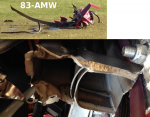Steve_UK
Active Member
- Joined
- Oct 15, 2010
- Messages
- 3,885
- Location
- UK
- Aircraft
- I'm not a pilot but have been lucky enough to fly in Mi-24 Hind, Mi-2, Mi-17, Lynx HAS3, Gliders, GA
Back in summer 2015 French ELA 07 registration 34-ACG suffered a fatal accident.
The official BEA report is now available -worth a read ( use Google Translate ) - appears to show two in flight welding failures
The report has photos of these cracks and also photos of a similar crack from another ELA.
.
Part of the report translates as
"Several witnesses indicate that the gyroplane then quickly returns to the runway threshold 32 with the empennage ( Steve - ie fuselage/frame ) that seems partly disassociated. They add that they hear him pass with an unusual noise. Moments later, the autogyro hits the ground violently" The report can be found here https://www.bea.aero/uploads/tx_elydbrapports/BEA2015-0318.pdf
The official BEA report is now available -worth a read ( use Google Translate ) - appears to show two in flight welding failures
The report has photos of these cracks and also photos of a similar crack from another ELA.
.
Part of the report translates as
"Several witnesses indicate that the gyroplane then quickly returns to the runway threshold 32 with the empennage ( Steve - ie fuselage/frame ) that seems partly disassociated. They add that they hear him pass with an unusual noise. Moments later, the autogyro hits the ground violently" The report can be found here https://www.bea.aero/uploads/tx_elydbrapports/BEA2015-0318.pdf


